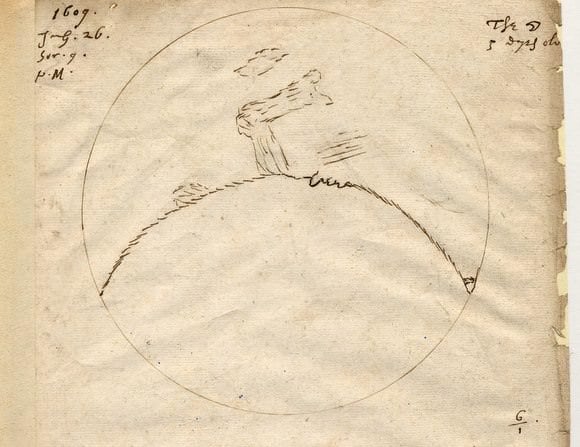[/caption] Italian Galileo Galilei has usually been attributed with making the first celestial observations with a telescope and then creating notations and drawings to record his observations. And that's the focus of what's being celebrated during this
International Year of Astronomy.
But a British historian is taking this opportunity to publicize the work of another astronomer, Thomas Harriot, who actually
was
the first person to create drawings of the what the Moon looks like through a telescope, doing so well before Galileo. Historian Allan Chapman says dated maps prove that Harriot drew Moon maps several months earlier than Galileo, in July 1609.
You can hear Chapman talk about Harriot in today's 365 Days of Astronomy Podcast.
Chapman says that according to historical documents, Harriot used a 'Dutch trunke' (telescope), and turned it towards the Moon on July 26, 1609, and created drawings, becoming the first astronomer to do so.
Historical documents show Galileo first observed the moons of Jupiter on January 7, 1610, and later made drawings of Earth's moon.
Harriot's crude drawings show a rough outline of the lunar terminator (the line marking the division between night and day on the Moon, as seen from the Earth) and includes a handful of features like the dark areas Mare Crisium, Mare Tranquilitatis and Mare Foecunditatis. [caption id="attachment_23631" align="aligncenter" width="200" caption="Harriot's drawing of the whole moon. Image: (c) Lord Egremont"]
[/caption] Harriot went on to produce further maps from 1610 to 1613. Not all of these are dated, but they show an increasing level of detail. By 1613 he had created two maps of the whole Moon, with many identifiable features such as lunar craters that crucially are depicted in their correct relative positions. [caption id="attachment_23632" align="aligncenter" width="177" caption="Thomas Harriot. Credit: RAS"]
[/caption] But Harriot remains relatively unknown. Unlike Galileo, he did not publish his drawings. Dr. Chapman attributes this to his comfortable position as a 'well-maintained philosopher to a great and wealthy nobleman' with a generous salary. Harriot had comfortable housing and a specially provided observing chamber on top of Sion House, all of which contrasted with Galileo's financial pressures.
Dr. Chapman believes that the time has come to give Harriot the credit he deserves. "Thomas Harriot is an unsung hero of science. His drawings mark the beginning of the era of modern astronomy we now live in, where telescopes large and small give us extraordinary information about the Universe we inhabit."
Source: RAS
 Universe Today
Universe Today
